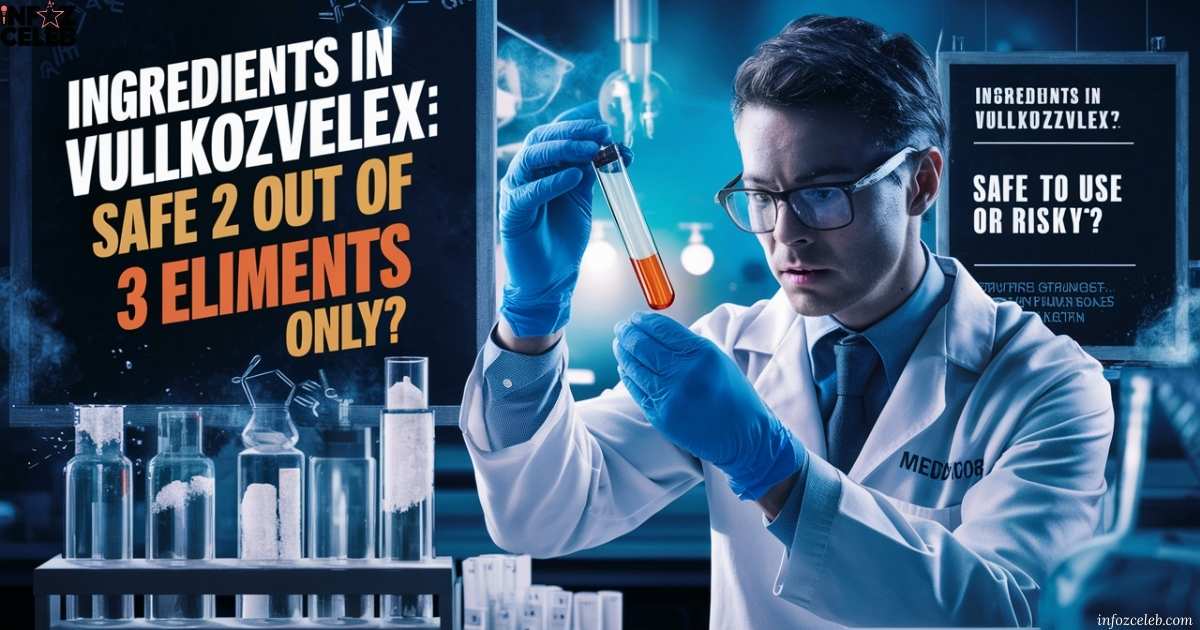The ingredients in Vullkozvelex play a big role in how the product works on your skin. Many users often wonder, are the ingredients in Vullkozvelex safe to use? That’s a fair question, especially when it comes to sensitive skin. The ingredients in Vullkozvelex include both active and inactive elements that work together to treat and protect the skin. From Salicylic Acid to Retinol, the ingredients in Vullkozvelex are known for targeting acne, dryness, and fine lines.
Understanding if the ingredients in Vullkozvelex are safe to use is important before adding it to your skincare routine. Some of the ingredients in Vullkozvelex safe to use have been tested and trusted by dermatologists, but others may cause irritation for certain skin types. That’s why it’s helpful to read labels and research each component. If you’re unsure whether the ingredients in Vullkozvelex are safe to use, consult with a skincare expert.
Understanding Vullkozvelex
Vullkozvelex represents an advanced concept or technology that is gaining attention across different fields. It aims to enhance productivity and streamline complex processes by introducing innovative solutions. This technology is designed to address modern challenges in industries like biotechnology, engineering, and digital systems.
The key to Vullkozvelex’s significance lies in its ability to offer high-performance solutions that can revolutionize traditional approaches. By understanding its principles, industries can unlock new potential for growth and efficiency, leading to substantial advancements in various sectors.
What is Vullkozvelex?
Vullkozvelex is a sophisticated system or product designed to improve efficiency in specific industries. While its precise definition may vary depending on the context, it typically refers to a set of advanced tools or technologies that offer innovative solutions to existing challenges.
At its core, Vullkozvelex aims to revolutionize current methodologies by providing smarter, faster, and more sustainable alternatives. Its applications are broad, ranging from healthcare to engineering, and understanding its role is crucial to harnessing its full potential for progress and improvement.
Purpose and Benefits
- Optimize performance and efficiency across various industries.
- Streamline complex processes and systems.
- Provide innovative solutions to existing challenges.
- Modernize and improve methodologies in fields like biotechnology, engineering, and digital systems.
Vullkozvelex increases productivity, reduces costs, and enhances precision in various industries. It fosters innovation and provides a competitive edge by streamlining processes and improving efficiency.
Breaking Down the Ingredients in Vullkozvelex

Breaking down Vullkozvelex’s ingredients reveals how each one targets specific skin concerns. Active ingredients like salicylic acid, niacinamide, retinol, and hyaluronic acid address acne, aging, and dehydration, while inactive ingredients such as parabens, fragrance, and alcohol play supportive roles but may cause irritation for sensitive skin. Understanding these components helps users make informed skincare choices.
Active Ingredients
The active ingredients in Vullkozvelex are crucial for providing the targeted skincare benefits. Each ingredient works to improve skin health by addressing specific concerns, from acne to aging. Understanding these ingredients helps in choosing the right product for your skincare routine.
- Salicylic Acid
- Function: Exfoliates the skin, clears pores, and reduces acne by removing dead skin cells.
- Concerns: May cause dryness, redness, or irritation, especially for those with sensitive skin.
- Additional Info: It’s best used in moderation and paired with a good moisturizer to avoid over-drying.
- Function: Exfoliates the skin, clears pores, and reduces acne by removing dead skin cells.
- Niacinamide
- Function: Reduces inflammation, improves skin texture, and helps lighten hyperpigmentation.
- Concerns: May cause slight irritation or redness for people with very sensitive skin.
- Additional Info: Known for its soothing properties and ability to strengthen the skin’s barrier.
- Function: Reduces inflammation, improves skin texture, and helps lighten hyperpigmentation.
- Retinol
- Function: Stimulates collagen production, reduces fine lines, wrinkles, and hyperpigmentation.
- Concerns: Can cause dryness, peeling, or irritation, especially for beginners or those with dry skin.
- Additional Info: Often recommended for nighttime use, as it can increase sensitivity to sunlight.
- Function: Stimulates collagen production, reduces fine lines, wrinkles, and hyperpigmentation.
- Hyaluronic Acid
- Function: Deeply hydrates the skin by attracting moisture and improving skin elasticity.
- Concerns: Can be ineffective in dry environments without a good moisture barrier to lock in hydration.
- Additional Info: A gentle ingredient suitable for all skin types, providing long-lasting moisture.
- Function: Deeply hydrates the skin by attracting moisture and improving skin elasticity.
Inactive Ingredients
Inactive ingredients play a supporting role in the formulation, providing texture, stability, and preservation. Though they don’t target specific skin concerns, they can influence how the product feels and functions on the skin. It’s important to be mindful of these, especially if you have sensitivities.
- Parabens
- Function: Act as preservatives to prevent bacterial growth and extend shelf life.
- Concerns: Can cause skin irritation and are potentially linked to hormone disruption.
- Additional Info: Paraben-free options are preferred by individuals with sensitive skin or concerns about long-term exposure.
- Function: Act as preservatives to prevent bacterial growth and extend shelf life.
- Fragrance
- Function: Adds a pleasant scent to enhance the user experience.
- Concerns: Commonly associated with allergic reactions, irritation, and sensitivities for people with delicate skin.
- Additional Info: Often unnecessary in skincare, fragrance-free options are recommended for sensitive skin.
- Function: Adds a pleasant scent to enhance the user experience.
- Alcohol
- Function: Helps to dissolve other ingredients and allows for quick absorption into the skin.
- Concerns: Can be drying, irritating, and may disrupt the skin’s natural moisture balance.
- Additional Info: Alcohol-free formulas are gentler and often preferred for dry or sensitive skin types.
- Function: Helps to dissolve other ingredients and allows for quick absorption into the skin.
Assessing the Safety of Active Ingredients
When considering skincare products, it’s essential to assess the safety of the active ingredients. Ensuring that each ingredient is safe and suitable for your skin type helps prevent adverse reactions.
Safety Profiles
The safety profile of active ingredients is determined by their effectiveness and potential side effects. Understanding how each ingredient interacts with the skin helps ensure safe and effective use.
- Ensure that active ingredients are within safe concentration ranges to avoid irritation.
- Some active ingredients may cause allergic reactions, so be mindful of your skin’s response.
- Long-term use of certain ingredients, like retinol, may require breaks to avoid skin sensitivity.
Expert Opinions
Experts often provide valuable insights into the safety and effectiveness of active ingredients. Relying on trusted skincare professionals ensures informed decisions when choosing products.
- Consult a dermatologist to ensure active ingredients are appropriate for your skin concerns.
- Look for products backed by clinical studies and scientific research on their safety.
- Expert reviews and consumer feedback can offer additional perspectives on product safety.
Evaluating the Risk of Inactive Ingredients
Inactive ingredients can often be overlooked, but they are vital in determining how a product works on your skin. It’s important to assess these ingredients for potential irritation or sensitivity.
Read More: Business Trend FTasiaFinance: The Unstoppable Rise of Financial Technology in Asia
Common Concerns
Inactive ingredients can raise various concerns for people with sensitive or reactive skin. It’s important to be mindful of these concerns when choosing a skincare product.
- Irritation: Many inactive ingredients, such as alcohol and fragrance, can cause skin irritation or allergic reactions.
- Long-Term Use: Continuous exposure to certain inactive ingredients may damage the skin barrier over time, leading to sensitivity.
- Comedogenic Properties: Some inactive ingredients can clog pores, leading to breakouts or acne flare-ups.
- Environmental Impact: Certain preservatives and additives can have a negative impact on the environment.
- Lack of Transparency: Some products may not disclose the full list of inactive ingredients, making it hard to assess potential risks.
Possible Side Effects
Inactive ingredients may cause side effects that affect skin texture, appearance, or overall health. Here are five possible side effects to be aware of:
- Dryness: Alcohol and certain preservatives may strip the skin of moisture, leading to dryness or peeling.
- Redness: Fragrances and alcohol can cause redness or irritation, especially for those with sensitive skin.
- Allergic Reactions: Some inactive ingredients can lead to allergic reactions such as rashes, swelling, or itching.
- Breakouts: Ingredients like parabens or silicones may clog pores and cause acne.
- Burning Sensation: Some alcohol-based or highly active ingredients can cause a stinging or burning sensation upon application.
Monitoring Reactions
It’s essential to monitor your skin’s reactions when using products with inactive ingredients. Here are steps to help track and manage skin reactions:
Patch Test: Conduct a patch test before using a new product to detect potential allergic reactions or irritation.
Track Symptoms: Keep a journal of any reactions, such as redness, irritation, or dryness, to assess trends over time.
What Experts Say About Vullkozvelex

Expert opinions help guide consumers in making informed skincare decisions. Insights from dermatologists and clinical studies provide essential information about the safety and efficacy of Vullkozvelex.
Dermatologist Insights
Dermatologists offer personalized insights that help consumers choose skincare products suited for their specific needs. Here are five key takeaways from dermatologists:
- Personalized Recommendations: Dermatologists help identify the right ingredients for each skin type, whether oily, dry, or sensitive.
- Active Ingredient Safety: They guide on the proper usage of active ingredients like retinol, ensuring safe application without overuse.
- Long-Term Skin Health: Dermatologists provide advice on maintaining long-term skin health through the right skincare regimen.
- Sensitive Skin Solutions: For those with sensitive skin, dermatologists often recommend products free from fragrances and harsh preservatives.
- Avoiding Irritation: They help avoid irritation by suggesting milder alternatives to products with potentially irritating inactive ingredients.
Clinical Studies and Findings
Clinical studies provide scientific evidence that supports the efficacy and safety of active ingredients. Here are five insights from clinical studies:
- Efficacy Validation: Clinical studies demonstrate the effectiveness of active ingredients like retinol and niacinamide in treating acne and aging.
- Safety Protocols: Research ensures that active ingredients are used within safe concentration levels to avoid adverse effects.
- Long-Term Results: Studies track the long-term effects of ingredients to ensure they do not cause lasting skin damage.
- Side Effect Monitoring: Clinical trials monitor and report any side effects, offering transparency for consumers.
- Comparative Studies: Some studies compare Vullkozvelex to other products to highlight its relative effectiveness and safety.
Better Alternatives for Safer Skincare
For those concerned about the risks of certain inactive ingredients, safer alternatives are available that offer similar benefits without the potential side effects.
Alternative Products
Exploring alternative products can help find better options for safer and more effective skincare. Here are five alternative products to consider:
- Gentle Cleansers: Opt for cleansers with soothing ingredients like glycerin or ceramides to avoid harsh chemicals.
- Natural Moisturizers: Use moisturizers with organic oils like jojoba or argan to nourish the skin without synthetic additives.
- Mineral Sunscreens: Mineral-based sunscreens with zinc oxide are effective and less irritating than chemical sunscreens.
- Toxin-Free Serums: Choose serums formulated without parabens, sulfates, or artificial dyes.
- Clean Beauty Brands: Many clean beauty brands focus on using safe, non-toxic ingredients that prioritize skin health.
Choosing the Right Product
Choosing the right product depends on several factors, including your skin type, concerns, and ingredient preferences. Here are five considerations for selecting the best skincare product:
- Know Your Skin Type: Understand whether your skin is oily, dry, or sensitive to choose products that cater to your needs.
- Ingredient Transparency: Look for products with clear ingredient lists to avoid hidden harmful additives.
- Specific Skin Concerns: Choose products designed to target your specific issues, such as acne, pigmentation, or wrinkles.
- Patch Test First: Always test new products on a small area of your skin to gauge its reaction.
- Brand Reputation: Opt for brands with positive reviews and dermatologist endorsements to ensure product quality.
Key Factors to Consider
When selecting a skincare product, several key factors should influence your decision.
Ingredient Awareness
Being aware of the ingredients in your skincare products helps you make informed decisions. Here are points to be mindful of:
Active vs. Inactive Ingredients: Know the difference between active ingredients (for treatment) and inactive ones (for texture and stability).
Sensitivity Considerations: Be aware of any known sensitivities you have, such as reactions to fragrance or alcohol.
Personal Skin Type and Sensitivities
Your skin type and sensitivities should always be considered when choosing a product. Here are five factors to consider:
Determine Your Skin Type: Understand whether your skin is dry, oily, combination, or sensitive to choose the right products.
Allergy Testing: If you have allergies, test products on a small area to avoid widespread reactions.
Resources for Further Research
If you want to dive deeper into skincare safety, ingredients, and expert advice, there are plenty of reliable resources. These can help you make informed choices and understand what’s really in your products.
- EWG’s Skin Deep Database: Offers ingredient safety ratings and product breakdowns based on scientific studies.
- PubMed: A great source for peer-reviewed clinical studies and dermatological research.
- The INCI Decoder: Helps you understand what each ingredient does and its safety profile.
- American Academy of Dermatology (AAD): Provides expert insights, safety guidelines, and skincare recommendations.
- Dermatologist Blogs and YouTube Channels: Professionals like Dr. Dray and Dr. Alexis Stephens share skincare advice backed by science.
FAQ’s
What are the most talked about ingredients in Vullkozvelex?
The formula includes well-known ingredients like Salicylic Acid, Retinol, and Niacinamide, often praised for treating acne, reducing wrinkles, and improving skin tone.
Can the ingredients in Vullkozvelex cause side effects?
Yes, some users report dryness, redness, or stinging, especially when overused or combined with other strong products like exfoliants or harsh treatments.
Are the ingredients in Vullkozvelex suitable for all skin types?
Not always. While some benefit from it, sensitive or dry skin types might react negatively depending on the combination of ingredients used in the formula.
Why do some people avoid the ingredients in Vullkozvelex?
People often avoid it due to certain inactive ingredients like alcohol or fragrance, which can cause irritation or sensitivity in delicate or allergy-prone skin.
How can I know if the ingredients in Vullkozvelex are okay for me?
Patch testing is a smart step. Try applying a small amount first and wait 24 hours to check for redness, itching, or irritation signs.
Conclusion
Understanding the ingredients in Vullkozvelex can help you make better skincare decisions. From active ingredients like Salicylic Acid and Niacinamide to inactive ones like fragrance and alcohol, each plays a different role. But the big question remains, are the ingredients in Vullkozvelex safe to use? The answer depends on your skin type and how it reacts to certain compounds. Some ingredients in Vullkozvelex safe to use for many people may still cause irritation for others.
Always check if the ingredients in Vullkozvelex match your skin needs. Talk to a dermatologist if you are unsure whether the ingredients in Vullkozvelex are safe to use on your skin. Patch testing is another good step to make sure the ingredients in Vullkozvelex safe to use for you. In the end, knowing what’s inside your skincare is key. So stay informed about the ingredients in Vullkozvelex and how they may affect your skin.
Welcome to Infoz Celeb! I’m Fredaston , Owner, Admin and Author of this Website.

